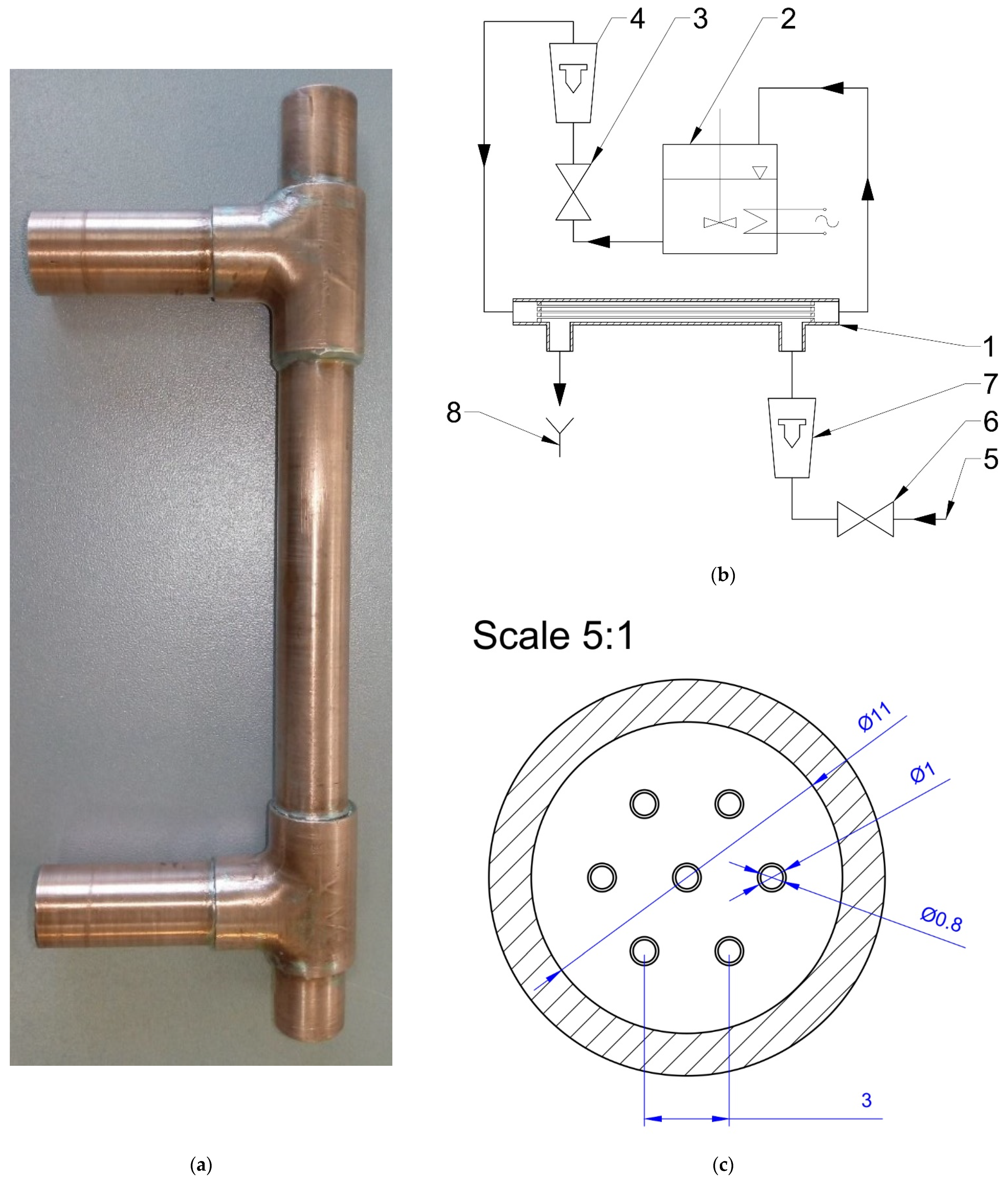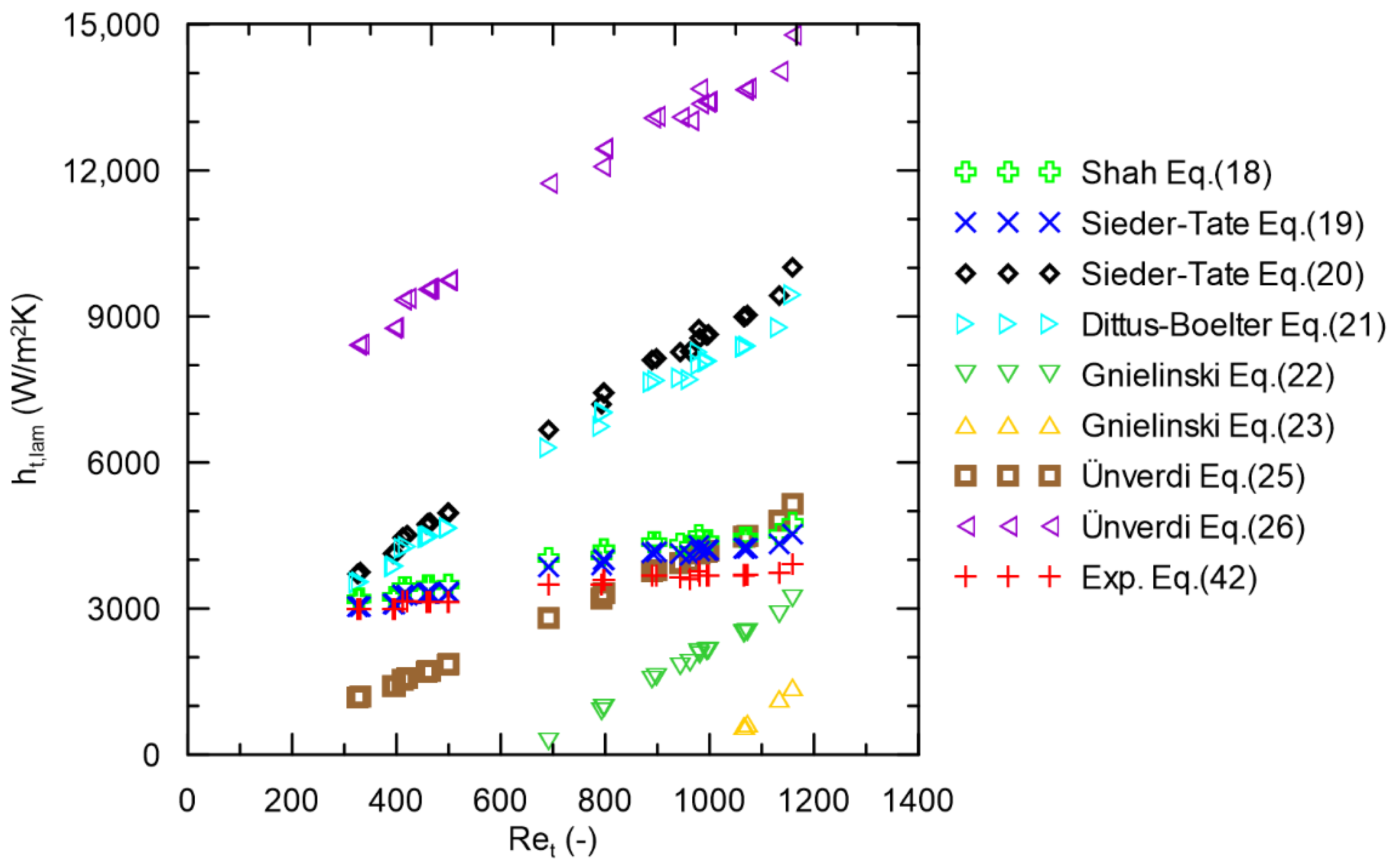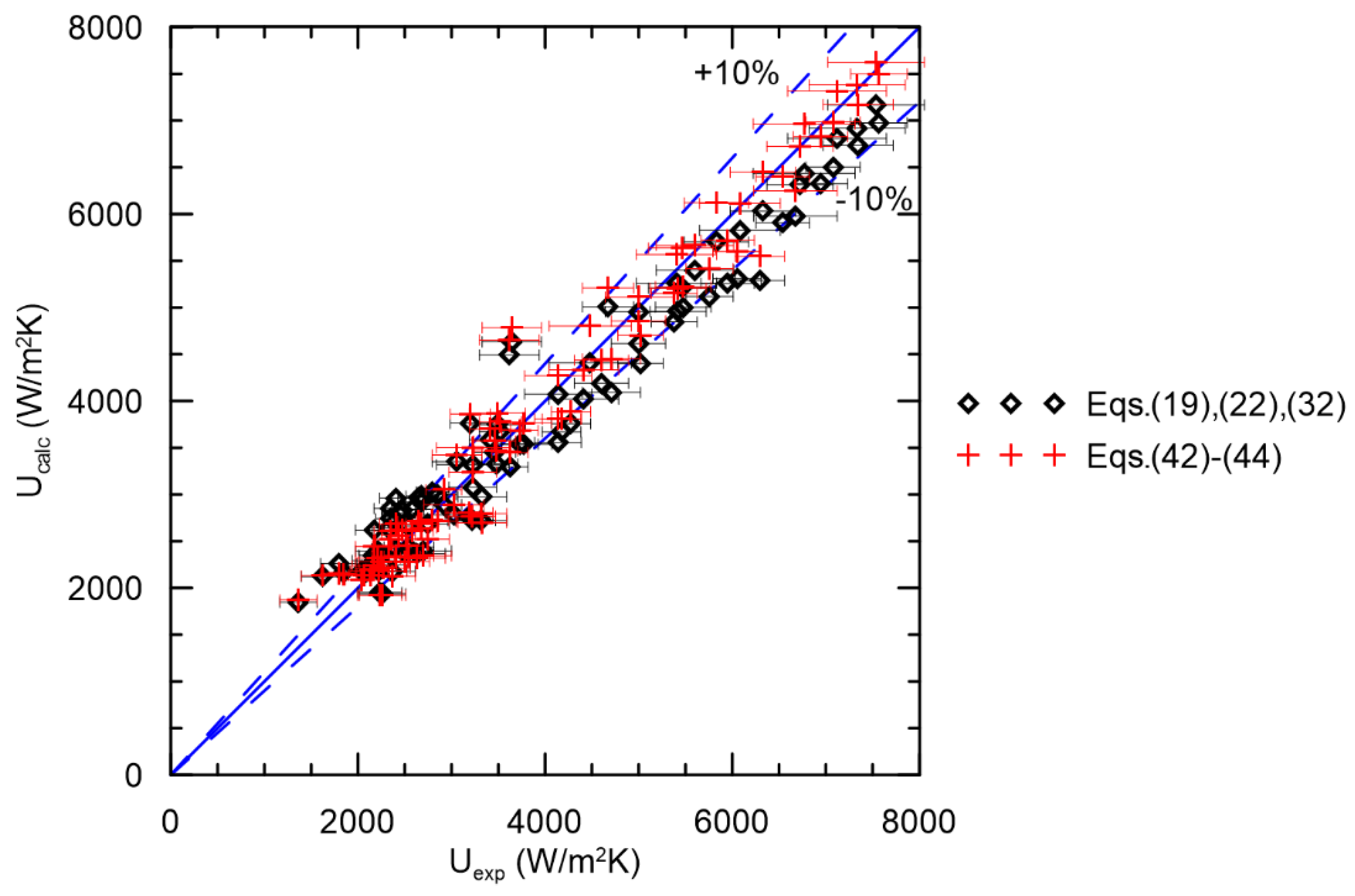Experimental Investigation of the Heat Transfer and Pressure Drop inside Tubes and the Shell of a Minichannel Shell and Tube Type Heat Exchanger
Abstract
:1. Introduction
2. Materials and Methods
2.1. Experimental Setup
2.2. Methods
2.2.1. Pressure Drop
- (a)
- The correlation for laminar fluid flow [26] (Equation (4)):
- (b)
- Blasius [28] correlation (Equation (5)):
- (c)
- Filonenko [29] correlation (Equation (6)):
- (d)
- Haaland [30] correlation (Equation (7)):
- (e)
- McAdams [31] correlation (Equation (8)):
2.2.2. Overall Heat Transfer, Shell and Tube Side Convective Heat Transfer
2.2.3. Determination of the Heat Transfer Coefficients
- (1)
- Initial assumption of the values of coefficients in Equation (39) and determination of the range of variation in these parameters.
- (2)
- Calculation of the values of Nusselt numbers for the tube and shell side flow based on experimental values of Reynolds and Prandtl numbers using Equations (33)–(35).
- (3)
- Calculation of the values of heat transfer coefficients based on Equation (16) and of the overall heat transfer coefficient using Equation (15).
- (4)
- Calculation of the value of the objective function using Equation (39).
- (5)
- Correcting the values of coefficients until the minimum of the function defined by Equation (39) is reached.
3. Results and Discussion
3.1. Tube Side Pressure Drop
3.2. Shell Side Pressure Drop
3.3. Convective Heat Transfer Coefficient
4. Conclusions
Author Contributions
Funding
Institutional Review Board Statement
Informed Consent Statement
Data Availability Statement
Conflicts of Interest
References
- Wu, P.; Little, W.A. Measurement of the heat transfer characteristics of gas flow in fine channel heat exchangers used for microminiature refrigerators. Cryogenics 1984, 24, 415–420. [Google Scholar] [CrossRef]
- Morini, G.L. Single–phase convective heat transfer in microchannels: A review of experimental results. Int. J. Therm. Sci. 2004, 43, 631–651. [Google Scholar] [CrossRef]
- Mehendale, S.S.; Jacobi, A.M.; Shah, R.K. Fluid flow and heat transfer at micro–and meso–scales with application to heat exchanger design. Appl. Mech. Rev. 2000, 53, 175–193. [Google Scholar] [CrossRef]
- Kandlikar, S.G.; Grande, W.J. Evolution of microchannel flow passages––thermohydraulic performance and fabrication technology. Heat Transf. Eng. 2003, 24, 3–17. [Google Scholar] [CrossRef]
- Al–Janabi, R.; Coletti, F.; Mahmoud, M.M.; Karayiannis, T.G. Experimental Study of Flow Boiling Using R134a in Multi Microchannels. In Proceedings of the 5th World Congress on Mechanical, Chemical, and Material Engineering (MCM’19), Lisbon, Portugal, 15–17 August 2019. Paper No. HTFF 133. [Google Scholar] [CrossRef]
- Kee, R.J.; Almand, B.B.; Blasi, J.M.; Rosen, B.L.; Hartmann, M.; Sullivan, N.P.; Zhu, H.; Manerbino, A.R.; Menzer, S.; Coors, W.G.; et al. The design, fabrication, and evaluation of a ceramic counter–flow microchannel heat exchanger. Appl. Therm. Eng. 2011, 31, 2004–2012. [Google Scholar] [CrossRef]
- Cao, H.; Chen, G.; Yuan, Q. Testing and design of a microchannel heat exchanger with multiple plates. Ind. Eng. Chem. Res. 2009, 48, 4535–4541. [Google Scholar] [CrossRef]
- Wang, Q.; Dai, C. Experimental study on heat transfer and pressure drop of micro–sized tube heat exchanger. Trans. Tianjin Univ. 2014, 20, 21–26. [Google Scholar] [CrossRef]
- Hejcik, J.; Jicha, M. Single phase heat transfer in minichannels. EPJ Web Conf. 2014, 67, 2034. [Google Scholar] [CrossRef] [Green Version]
- Col, D.D.; Cavallini, A.; Da Riva, E.; Mancin, S.; Censi, G. Shell–and–tube minichannel condenser for low refrigerant charge. Heat Transf. Eng. 2010, 31, 509–517. [Google Scholar] [CrossRef]
- Yan, Y.Y.; Lin, T.F. Condensation heat transfer and pressure drop of refrigerant R–134a in a small pipe. Int. J. Heat Mass Tran. 1999, 42, 697–708. [Google Scholar] [CrossRef]
- Adams, T.M.; Abdel–Khalik, S.I.; Jeter, S.M.; Qureshi, Z.H. An experimental investigation of single–phase forced convection in microchannels. Int. J. Heat Mass Tran. 1998, 41, 851–857. [Google Scholar] [CrossRef]
- Ünverdi, M.; Kücük, H.; Yılmaz, M.S. Experimental investigation of heat transfer and pressure drop in a mini–channel shell and tube heat exchanger. Heat Mass Tran. 2019, 55, 1271–1286. [Google Scholar] [CrossRef]
- Kücük, H.; Ünverdi, M.; Yılmaz, M.S. Experimental investigation of shell side heat transfer and pressure drop in a mini–channel shell and tube heat exchanger. Int. J. Heat Mass Tran. 2019, 143, 118493. [Google Scholar] [CrossRef]
- Rajalingam, A.; Chakraborty, S. Effect of shape and arrangement of micro–structures in a microchannel heat sink on the thermo–hydraulic performance. Appl. Therm. Eng. 2021, 190, 116755. [Google Scholar] [CrossRef]
- Ahmed, H.E.; Kherbeet, A.S.; Ahmed, M.I.; Salman, B.H. Heat transfer enhancement of micro–scale backward-facing step channel by using turbulators. Int. J. Heat Mass Tran. 2018, 126, 963–973. [Google Scholar] [CrossRef]
- Zhuang, D.; Yang, Y.; Ding, G.; Du, X.; Hu, Z. Optimization of microchannel heat sink with rhombus fractal-like units for electronic chip cooling. Int. J. Refrig. 2020, 116, 108–118. [Google Scholar] [CrossRef]
- Jung, S.Y.; Park, H. Experimental investigation of heat transfer of Al2O3 nanofluid in a microchannel heat sink. Int. J. Heat Mass Tran. 2021, 179, 121729. [Google Scholar] [CrossRef]
- Ekiciler, R.; Arslan, K. CuO/water nanofluid flow over microscale backward-facing step and analysis of heat transfer performance. Heat Tran. Res. 2018, 49, 1489–1505. [Google Scholar] [CrossRef]
- Engineering Thermal Properties of Metals, Conductivity, Thermal Expansion, Specific Heat—Engineers Edge. Available online: https://www.engineersedge.com/properties_of_metals.htm (accessed on 29 November 2021).
- Vishay–NTC Thermistors, Radial Leaded Special Accuracy. Available online: https://www.vishay.com/docs/29046/ntcls101.pdf (accessed on 30 November 2021).
- Atmel ATmega328P Datasheet. Available online: https://ww1.microchip.com/downloads/en/DeviceDoc/Atmel–7810–Automotive–Microcontrollers–ATmega328P_Datasheet.pdf (accessed on 29 November 2021).
- AN118–Improving ADC Resolution by Oversampling and Averaging. Available online: https://www.cypress.com/file/236481/download (accessed on 30 November 2021).
- Pharmacy Vaccine Low Temperature Data Logger Termio–1. Available online: https://termoprodukt.co.uk/industrial–fridge–temperature–external–sensor–data–recorder–termio–1 (accessed on 9 November 2021).
- Dwyer—Series 4000 CAPSUHELIC® Differential Pressure Gage. Available online: https://www.dwyer–inst.com/Product/Pressure/DifferentialPressure/Gages/Series4000 (accessed on 29 November 2021).
- White, F.M. Fluid Mechanics, 7th ed.; McGraw–Hill: New York, NY, USA, 2011. [Google Scholar]
- Reynolds, O. On the dynamical theory of incompressible viscous fluids and the determination of the criterion. Philos. Trans. R. Soc. Lond. 1895, 186, 123–164. [Google Scholar] [CrossRef]
- Blasius, H. Boundary Layers in Liquids with Low Friction. Z. Math. Phys. 1908, 56, 1–37. (In German) [Google Scholar]
- Filonenko, G.K. Hydraulic resistance in pipes. Teploenergetika 1954, 1, 40–44. (In Russian) [Google Scholar]
- Haaland, S.E. Simple and Explicit Formulas for the Friction Factor in Turbulent Pipe Flow. J. Fluids Eng. 1983, 105, 89–90. [Google Scholar] [CrossRef]
- McAdams, W.H. Heat Transmission, 3rd ed.; McGraw–Hill: New York, NY, USA, 1954. [Google Scholar]
- Nusselt, W. The dependence of the heat transfer coefficient on tube length. Zeit. VDI 1910, 54, 1154–1158. (In German) [Google Scholar]
- Shah, R.K. Thermal entry length solutions for the circular tube and parallel plates. In Proceedings of the 3rd National Heat and Mass Transfer Conference, Bombay, India, 11–13 December 1975; Indian Institute of Technology Bombay: Mumbai, India, 1975; Volume 1, pp. 11–75. [Google Scholar]
- Sieder, E.N.; Tate, G.E. Heat transfer and pressure drop of liquids in tubes. Ind. Eng. Chem. 1936, 28, 1429–1435. [Google Scholar] [CrossRef]
- Dittus, F.W. Heat transfer in automobile radiators of the tube type. Univ. Calif. Pubs. Eng. 1930, 2, 443. [Google Scholar]
- Gnielinski, V. New Equations for Heat and Mass Transfer in Turbulent Pipe and Channel Flow. Int. Chem. Eng. 1976, 16, 359–368. [Google Scholar]
- Hausen, H. New equations for heat transfer with free or forced flow. Allg. Waermetech 1959, 9, 75–79. (In German) [Google Scholar]
- Nitsche, M.; Gbadamosi, R.O. Heat Exchanger Design Guide: A Practical Guide for Planning, Selecting and Designing of Shell and Tube Exchangers; Butterworth–Heinemann: Oxford, UK, 2015. [Google Scholar]
- Weisman, J. Heat transfer to water flowing parallel to tube bundles. Nucl. Sci. Eng. 1959, 6, 78–79. [Google Scholar] [CrossRef]
- Kozioł, K. Heat transfer in turbulent flow on the shell side of nonbaffled exchangers with standard and squeezed tubes. Chem. Stosowana 1965, 4B, 359. (In Polish) [Google Scholar]
- Find Minimum of Constrained Nonlinear Multivariable Function. Available online: https://www.mathworks.com/help/optim/ug/fmincon.html (accessed on 10 November 2021).








| Location | Temperature Range |
|---|---|
| Hot water inlet temperature | 35–60 °C |
| Hot water outlet temperature | 24–46 °C |
| Cold water inlet temperature | 19–21 °C |
| Cod water outlet temperature | 19–25 °C |
| Ambient temperature | 23–26 °C |
| Coefficient | Lower Bound | Upper Bound |
|---|---|---|
Publisher’s Note: MDPI stays neutral with regard to jurisdictional claims in published maps and institutional affiliations. |
© 2021 by the authors. Licensee MDPI, Basel, Switzerland. This article is an open access article distributed under the terms and conditions of the Creative Commons Attribution (CC BY) license (https://creativecommons.org/licenses/by/4.0/).
Share and Cite
Prończuk, M.; Krzanowska, A. Experimental Investigation of the Heat Transfer and Pressure Drop inside Tubes and the Shell of a Minichannel Shell and Tube Type Heat Exchanger. Energies 2021, 14, 8563. https://doi.org/10.3390/en14248563
Prończuk M, Krzanowska A. Experimental Investigation of the Heat Transfer and Pressure Drop inside Tubes and the Shell of a Minichannel Shell and Tube Type Heat Exchanger. Energies. 2021; 14(24):8563. https://doi.org/10.3390/en14248563
Chicago/Turabian StylePrończuk, Mateusz, and Anna Krzanowska. 2021. "Experimental Investigation of the Heat Transfer and Pressure Drop inside Tubes and the Shell of a Minichannel Shell and Tube Type Heat Exchanger" Energies 14, no. 24: 8563. https://doi.org/10.3390/en14248563
APA StylePrończuk, M., & Krzanowska, A. (2021). Experimental Investigation of the Heat Transfer and Pressure Drop inside Tubes and the Shell of a Minichannel Shell and Tube Type Heat Exchanger. Energies, 14(24), 8563. https://doi.org/10.3390/en14248563






